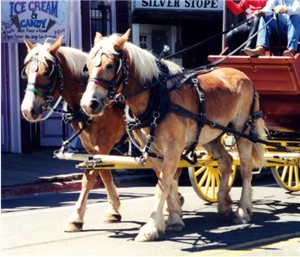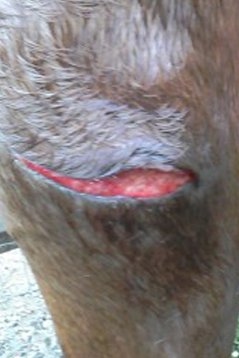Equine Scratches
What It is and How to Treat It
Equine scratches, is a chronic skin condition that effects the horses lower leg. Sometimes called greasy heel, the true name is dermatitis verrucosa… a seborrheic dermatitis.
The exact cause of scratches is unknown, but it is often associated with poor stable conditions, wet environments and exposure to the limestone used on race tracks.
Bacteria love wet and/or unsanitary environments. Once the skin on a horse's pasterns has become compromised the bacteria begins to grow and invade the tissues.
Although horse scratches can be found on all four legs, it is most often found on the back feet, specifically pastern and fetlock areas.
Heavy draft type breeds seem to be the most susceptible to getting greasy heel.
Most likely these draft breeds are more easily affected because of the tendency for them to have long feathered hair on the back of their pasterns. This long thick hair holds moisture to the skin creating its own moist micro-climate.
Symptoms of Equine scratches
- Unhealthy odor from pasterns
- soft greasy residue on skin
- hair loss
- animal shows signs of discomfort
- Itchiness in early stages
- Swelling in early stages
- Skin thickening
- Granulose tissue growth on affected area
- Lameness in advanced stages
It has been called ‘scratches’ because it’s itchy! Horses bothered by scratches will try to scratch their itchy fetlocks and pasterns. Its also been called ‘greasy heal’ because the affected skin will give off a greasy soft grayish exudate. That’s a fancy term for the thick greasy fluid produced by the affected skin.
Equine Scratches or 'Mud Fever'
What you are really fighting is a bacterial infection in a 'hard to keep clean' area on a horse.
In the early stages a horse owner may not realize their horse has equine scratches because of the thick hair covering the area. The exudate gives off an unhealthy odor. It’s usually a combination of the smell, greasy hair, the horses itchy behavior and hair loss that gives the disease away.
The skin is most itchy, sensitive and swollen in the earlier stages. Over time the skin thickens and the hair is lost. Skin on the surface can get a granulose type growth while the deep tissue layers under the skin will also thicken and harden. Horses may or may not show sings of lameness.
If left untreated the skin will loose the normal ability to fight off bacteria. A bacterial infection of the deep tissue layers will require antibiotics. The horses natural defenses against tetanus are also greatly compromised.
Treating Equine Scratches
Because horse scratches tend to be chronic, it is important that it be treated aggressively. Treatment consists of washing the affected area with mild soap and warm water. You’ll need to scrub the greasy gray exudate and dead tissue away from the skin with a brush. Dry the area completely. Then apply a dressing to the affected skin. You may need to shave or cut the hair while actively treating scratches.
Treatment is simple but often takes persistence and diligence to get results.
Your vet will most likely give you an astringent dressing. An astringent is a topical dressing that helps to reduce tissue enlargement. This will encourage the skin not to thicken.
To discourage bacterial growth you must change the environment that the bacteria is living in. This means keeping your horse's feet and pasterns dry and clean. Take every measure to house your horse on dry ground. Reduce your horses exposure to urine and manure soaked mud or bedding, as they will only worsen the condition of scratches.
The best defense against equine scratches is vigilance, especially if you have a draft, a draft cross or a horse with feathers or very thick hair on their fetlocks. The signs can be easy to miss.
If you’re not looking for it, you may not see it. Protect you horse by taking the opportunity to inspect their pasterns and fetlocks periodically. If you catch it soon enough, you can prevent it from becoming a chronic situation.
More Equine Topics You May Enjoy
This information is written for the horseman to better understand and cope with the variety of disease and injury that can occur during the course of horse ownership. Always consult with your Veterinarian regarding the care and treatment of your equine.
Home > Horse Diseases > Equine Scratches



